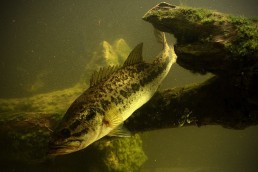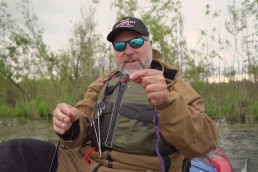Getting ‘Cranked’ up to Find the School
SHARE THIS POST
Look in any angler’s boat or tackle box and you’re going to find crankbaits. And if they are somewhat seasoned at fishing, then there are probably lots. Most of the crankbaits are on the bench, just waiting for the coach to call their name “to play.” They all do have a time when they shine. And that’s why it’s important to put them in the line up in order to cash in on their effectiveness. And, just like in The Show, there is a time and place to insert a “pinch-hitter” to give you more confidence and to play the percentages with a lure.
I remember many times that I have been pleasantly surprised during a tournament when a crankbait came through in the clutch and actually gave us our biggest fish of the tournament. It’s a different look, and a reaction from the fish is necessary. Other presentations can be slow in and around the bottom where bass can zero in with ease and inspect the offering and decide what to do. Faster-moving baits require a reaction from the fish. But knowing when to force this on a fish is what separates the good from the great. But truth be told, you don’t have to be the fish whisperer—just have a game plan based on giving the fish different options so they can tell you what they’re interested in.
One of the easiest ways to build confidence in cranks is to use it to search. They can be a tremendous asset for uncovering new areas and finding a new sweet spot. Weed beds don’t always grow the same year to year, so fish will move to what suits them better. Sometimes it can be tough to find the right place to use crankbaits, particularly in lakes that contain a lot of vegetation. Constant fouling of the hooks with weeds will always dampen your interest in continuing the course. But with a plethora of good lure choices for bass, this fact can actually make decisions easier. Any emergent vegetation is out of the question for cranks, even weeds that grow close to the surface. So that leaves the options of cleaning the bottom areas, rocks, weeds close to the bottom or the edges of cover.
If you want to excel, you need a variety of presentations to be able to probe all the key hideouts for bass. In the thick stuff, use your jigs and Texas-rigged soft plastics, but in other locales, tickle the edges with cranks. Weeds do provide ample ambush spots for predatory fish. And, there are always premium locations that these fish prefer for a variety of reasons such as cover, temperature and proximity to food. Again, having a variety of crankbaits will allow you to get to the right places. This time of the year bass will school-up on the edges of deeper water. Offshore humps and the edges of weedlines are great places to probe with crankbaits. Knowing how deep the bottom is or the weeds are and how deep your lure will dive, are keys to your success. The DT series from Rapala makes it easier, as a DT-6 dives to 6 feet on a normal cast and the DT-10 dives to 10 feet. The live-color patterns of bluegills are a fantastic choice for this time of the year. You can always use trial and error if you don’t know how deep the lure dives, but it can be a little frustrating. Remember to keep the crankbaits for the edges and the weedless lures for the “jungle.” Approach a weed edge and try to cast parallel to the edge. This will keep your lure in the strike zone longer and can increase success. Bass will often hang out near the bottom loosely near the weed edge.
Are you enjoying this post?
You can be among the first to get the latest info on where to go, what to use and how to use it!
On offshore humps, you’ll want to skim the top if possible and definitely the edges. Sometimes it takes the right angle of a cast to get their attention, and then it can be lights out. So, on humps, don’t be afraid to circle around it with your casts.
Some of the best bass anglers in the world will always impart a wounded action into their retrieve. They stop and pause or jerk the rod while reeling in to make the bait look a little off and vulnerable. This can cause the instincts in bass to jump at the opportunity. It is also very natural for baitfish to stop, start, and dart rather than just steadily move—you’ll always be pleased when you mimic the real thing. The Rapala Scatter Rap was designed with this in mind. This variation in the lure while we anglers just reel in is ideal. These are also great choices to be tossing around on the edges.
Once you develop the confidence in hard baits you’ll wonder what took you so long to get them off the bench and trust them. These are used by many pros on a daily basis to help them earn a check. Start using them today to scratch the edges of cover, locate a school and create a fun way to catch your favorite fish.
MWO
SHARE THIS POST
Did you enjoy this post?
You can be among the first to get the latest info on where to go, what to use and how to use it!
Steve Mattson
Steve Mattson has been writing articles for MidWest Outdoors since 2001. He is a driven angler, guide and sponsored tournament pro who has won both bass and panfish tournaments, and has placed in walleye and pike events. He resides in northern Minnesota and enjoys helping others catch more fish. For more info: mattsonangling.com and @mattsonangling.



